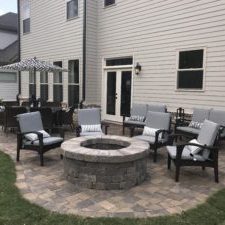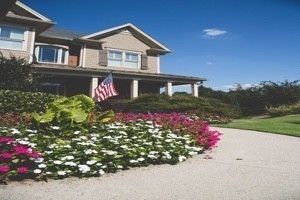Creating a garden with raised beds can transform your outdoor space into a beautiful and functional area. Raised beds make it easier to manage soil quality, grow healthy plants, and enjoy gardening. They bring plants to an accessible height, reducing strain on your back while adding a neat and organized look to your yard.
Selecting materials that suit your needs and tastes ensures your raised beds are durable and attractive. From wood to metal, the options vary in style and environmental impact. With simple tools and proper planning, you can construct raised beds that contribute to your garden’s beauty and support sustainable gardening practices.
Choosing the Right Location
Location is key when setting up your raised garden beds. Start by assessing the sun and shade needs of the plants you plan to grow. Most vegetables and flowers thrive with at least six hours of direct sunlight a day. If plants prefer partial shade, position your beds accordingly to ensure they receive some relief from the midday sun.
Consider the accessibility and aesthetic appeal of your chosen spot. A location near the kitchen can conveniently gather fresh herbs or vegetables while cooking. Additionally, you’ll want your raised beds to enhance the overall look of your outdoor space. Placing them strategically near patios or garden paths helps weave them into the design of your landscape, creating a cohesive appearance.
Remember to plan for watering and drainage. Ensure the beds are close to a water source or install a simple drip irrigation system. Watering regularly becomes less of a chore and more of an integral part of maintaining your garden’s health. Make sure the area allows water to flow naturally away from the beds to prevent waterlogging, which can damage plant roots. Choosing the right location sets the stage for a thriving and visually pleasing garden.
Selecting Materials for Your Raised Beds
Choosing the right materials for your raised beds affects both their look and longevity. Wood, metal, and composite options each have their advantages. Wood, like cedar or redwood, is a popular choice due to its natural appearance and resistance to rot. Metal beds, made from steel or aluminum, offer durability and a modern look, ideal for contemporary garden designs. Composite materials combine wood fibers and recycled plastics, providing a low-maintenance option with a polished finish.
When comparing these options, consider both durability and environmental impact. Wood is biodegradable but may need replacing over time. Metal can last many years without rotting but can become quite hot in sunny areas. Composites provide a long-lasting, sustainable choice with minimal upkeep.
Here are some tips to help you choose the best material for your style:
1. Match your raised bed material with existing outdoor features, like furniture or decking, for a unified look.
2. Consider the climate in your area; in humid environments, metal can resist decay, while wood might be preferred for its insulation properties in cooler areas.
3. Think about how much time you want to spend on maintenance. Wood may need treating or sealing, while composites require little ongoing care.
By selecting materials that fit your design goals and environmental considerations, you ensure that your raised beds are functional and enhance your garden’s beauty.
Building and Assembling Raised Beds
Constructing a raised bed is a rewarding project that enhances your garden’s functionality. Follow this step-by-step guide to ensure a sturdy and long-lasting build:
1. Choosing a Site: Begin by selecting a flat area with good sunlight. Ensure it’s accessible for watering and maintenance.
2. Gathering Materials: You’ll need lumber or your chosen building material, screws, and a drill. Ensure materials are rot-resistant if possible.
3. Measuring and Cutting: Measure and cut the boards to your desired dimensions. Make sure to have four equal sides for a rectangular shape.
4. Assembling the Frame: Start by constructing the short sides. Attach the longer sides to complete the rectangle. Make sure corners are square to maintain stability.
5. Adding Reinforcements: For larger beds, add a middle brace to prevent bowing.
6. Securing to the Ground: Position your bed and ensure it’s level once assembled. Secure the frame with stakes driven into the ground in each corner.
7. Ensuring Drainage: Provide good drainage by laying landscape fabric at the bottom before filling with soil.
Important tools include a saw for cutting, a power drill for fastening, and a level to ensure even construction. Taking your time with these steps ensures your raised bed withstands the elements and supports healthy plant growth.
Designing Your Plant Layout
A well-thought-out plant layout maximizes raised bed productivity and aesthetics. Start by deciding on the types of plants you want to grow. Consider mixing vegetables with flowers to enhance both beauty and biodiversity. Select companion plants that support each other’s growth, like tomatoes with basil or carrots with onions.
Focus on spacing and arranging plants to balance visual appeal and health. Tall plants like sunflowers and tomatoes should be placed at the back or center of the bed, while shorter plants like lettuce stay at the front. This arrangement allows every plant to receive adequate sunlight and prevents shading.
Incorporate mulch and soil amendments to improve growth conditions. Use organic mulch, such as straw or wood chips, to retain moisture and suppress weeds. Add amendments like compost or peat moss to enrich the soil and provide nutrients. Proper plant layout planning not only enhances the garden’s look but also boosts the success of your crops.
Conclusion
Designing and creating a raised bed garden transforms your outdoor space into a productive, attractive oasis. By carefully selecting location, materials, and construction techniques, you ensure your garden will be functional and beautiful. Thoughtful plant layout and maintenance maximize yield and aesthetic appeal, rewarding your gardening efforts.
Raised beds offer flexibility in plant selection and garden design, allowing you to customize your outdoor space to suit your needs and preferences. Whether you’re planting herbs, vegetables, or flowers, a well-crafted raised bed simplifies gardening tasks and enhances growth. As you plan and build your garden, consider how each decision contributes to the harmony and efficiency of your space.
Transform your covered outdoor living spaces into a lush garden with ease and expertise. Contact Sugar Hill Outdoors to guide you through creating raised beds that fit your vision. Our team of professionals helps you design and build beautiful gardens that enhance your outdoor living area with personalized care and creative solutions.





